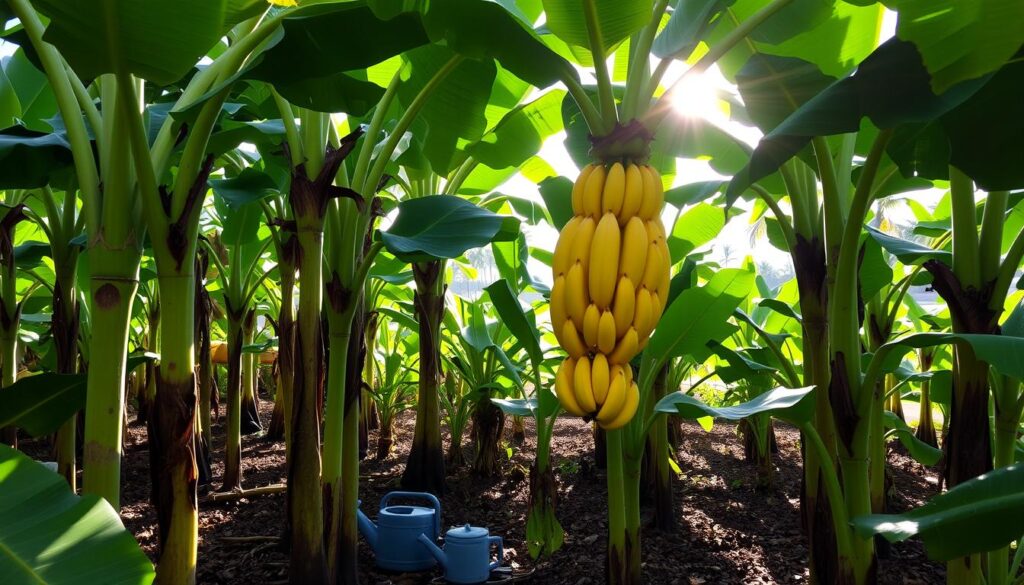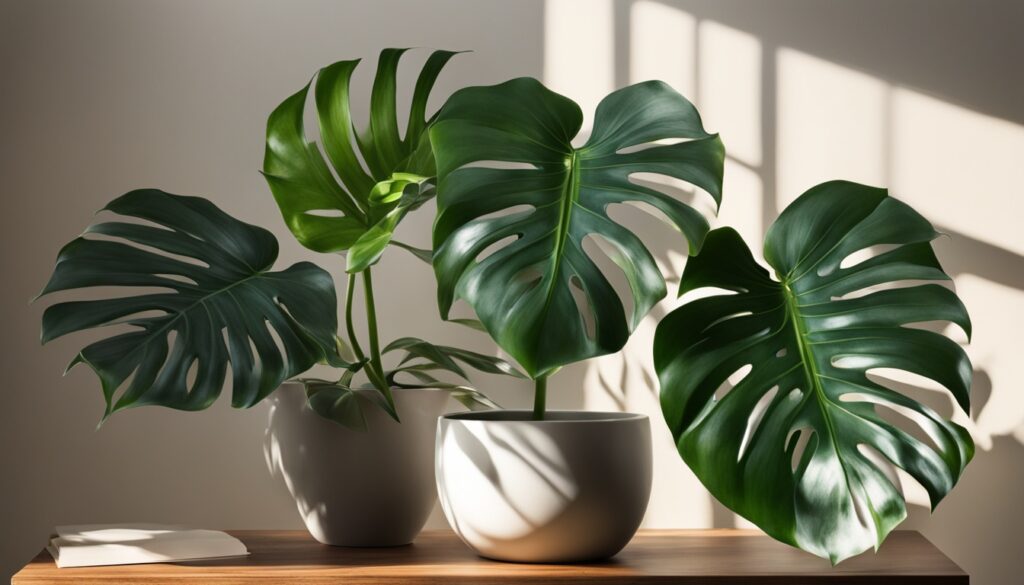Are you fascinated by banana plants’ lush leaves and quick growth? They belong to the Musaceae family, with over 60 species. The Musa Dwarf Cavendish, a favorite for indoor spaces, grows 0.8-1.2 meters tall. Yet, despite looking like trees, banana plants are actually herbs that need special care.
In this guide, we’ll share expert tips for banana care. You’ll learn how to grow these tropical plants to their best. We’ll cover everything from their origins to the basics of light, water, temperature, and soil. This article is perfect for both experienced plant lovers and beginners wanting to add a tropical touch to their homes.
Key Takeaways
- Banana plants belong to the Musaceae family, with over 60 species to choose from.
- The Musa Dwarf Cavendish is a popular indoor banana variety, growing 0.8-1.2 meters tall.
- Banana plants have been cultivated since the 6th century, making them one of the oldest commercial indoor plants.
- Proper care, including adequate light, water, humidity, and temperature control, is essential for healthy banana plant growth.
- Understanding the unique needs and characteristics of banana plants is the key to mastering their care and cultivation.
Understanding the Banana Plant: Origins and Characteristics
Banana plants come from the Musaceae family and have over 60 species. They started in South-East Asia and Australia and have been grown since the 6th century. The Musa Dwarf Cavendish was named after William Cavendish, showing the plant’s long history.
People often think banana plants are trees, but they are actually giant herbs. Their “trunk” is made of leaf stalk bases packed tightly together. These plants have big, shiny green leaves and can grow fast if they have the right conditions.
Native Habitat and Historical Background
Banana plants come from the warm areas of South-East Asia and Australia. They have been grown for centuries because of their tasty fruit and cultural value.
Different Types of Banana Plants
- The Musa Dwarf Cavendish is great for indoor spaces because it’s small and has lots of leaves.
- The Japanese banana (Musa basjoo) can handle UK winters and is very hardy.
- The Red Abyssinian banana (Ensete ventricosum ‘Maurelii’) has leaves that are red and look amazing.
Basic Plant Structure and Growth Patterns
Banana plants are not trees but have a special structure. Their “trunk” is made of leaf stalk bases. Their leaves can be up to 2 meters long, making them look very tropical. They need warm, sunny places to grow well and need water and food to grow fast.
| Banana Variety | Hardiness | Leaf Color | Mature Height |
|---|---|---|---|
| Musa Dwarf Cavendish | Tender | Green | 1 meter |
| Japanese Banana (Musa basjoo) | Hardy | Green | 3 meters |
| Red Abyssinian Banana (Ensete ventricosum ‘Maurelii’) | Tender | Red-tinted | 2 meters |
Essential Light Requirements for Healthy Growth
Banana plants love sunlight. Most types need direct sunlight for 6 hours a day. Others do well with bright, indirect light. Make sure not to put banana plants in direct southern windows to avoid leaf burn.
Direct vs. Indirect Sunlight Needs
Outdoor banana plants need 6-8 hours of direct sunlight daily. Indoor banana plants need 12-16 hours of light, from natural or artificial sources, to stay healthy.
Optimal Placement in Your Home
- Place banana plants near east- or west-facing windows for bright, indirect light.
- Avoid direct southern exposure to prevent leaf scorch and wilting.
- If natural light is not enough, use energy-efficient LED grow lights.
Signs of Inadequate Light Exposure
Banana plants show signs if they don’t get enough light, like:
- Yellowing or pale leaves
- Elongated, stretching stems
- Stunted growth and lack of new leaves
Watch the leaf color closely. Reddish-brown leaves mean too much sun. Yellow leaves mean they need more light.
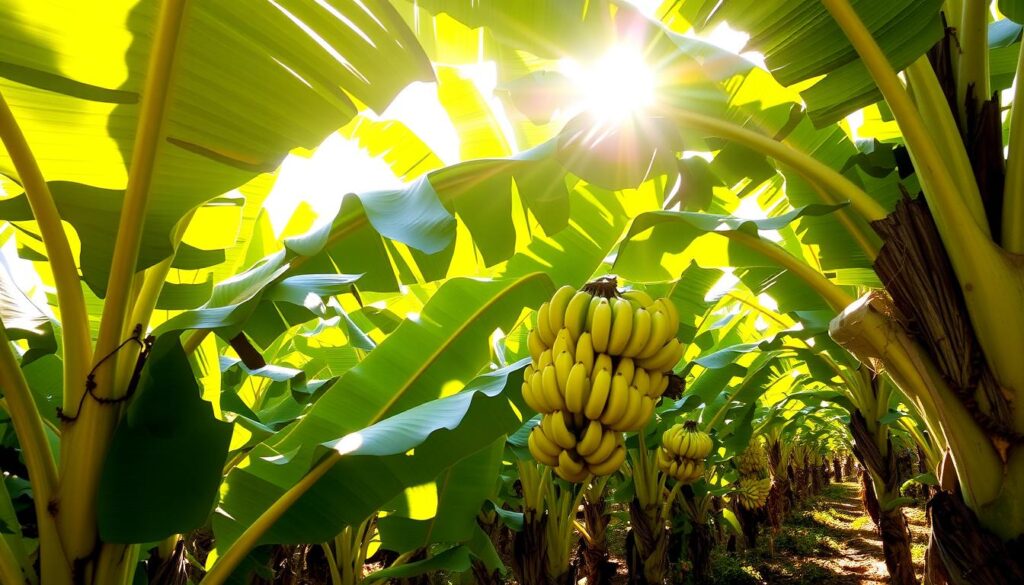
Water Management and Soil Moisture
Proper water management is key for banana plants’ health. They need consistent moisture but can’t handle waterlogged soil. Water when the top 2-3 cm of soil feels dry, using room temperature water to avoid shocking the plant.
Too much water can cause root rot and yellow leaves. It’s important to ensure good drainage to prevent water from staying too long. Use a water meter or a finger test to check soil moisture. Adjust watering based on the environment and plant size.
- Banana plants need about 10-20 liters of water daily. This can go up to 40 liters in very hot and dry places.
- They need water every day because they use a lot and can’t handle too much stress.
- Use tensiometers to manage water, checking different depths to find the best watering schedule.
Good water management boosts crop yield and quality. It also saves water and makes pumping more efficient. By learning how to water bananas right, you’ll keep your plants healthy and strong.
“Proper water management is the foundation for thriving banana plants. Striking the right balance is key to unlocking their full potential.”
Creating the Perfect Temperature Environment
Banana plants love warm, tropical weather. They grow best between 70-85°F (19-30°C). But, they don’t do well in cold, below 60°F (15°C), as it can stress them out.
The coldest they can handle is about 50°F (10°C). But, the Musa Dwarf Cavendish variety can handle a bit colder.
Ideal Temperature Ranges
Banana plants need steady, warm temperatures to grow well and produce fruit. Big changes in temperature can harm. This can cause leaf damage, slow growth, and less fruit.
Keeping the right temperature is key to keeping your banana plants healthy and strong.
Protecting from Temperature Fluctuations
To keep banana plants safe from sudden temperature changes, try these tips:
- Plant them near tall plants or use shade cloth to block harsh winds and direct sunlight.
- Use horticultural fleece or a wire frame with straw or dry bracken to keep the trunk warm in cold months.
- Put a polythene sheet over the plant to keep rain out of the protective structure.
- Use mulch around the plant to keep the soil warm and retain moisture.
Seasonal Temperature Considerations
In cooler places, move banana plants outside when it’s warm enough. This means when it’s over 50-60°F (10-15°C) at night. Bring them inside or put them in a greenhouse when it gets cold.
Cold-tolerant varieties like Musa Basjoo can handle cooler weather. They might be okay outside in some areas.
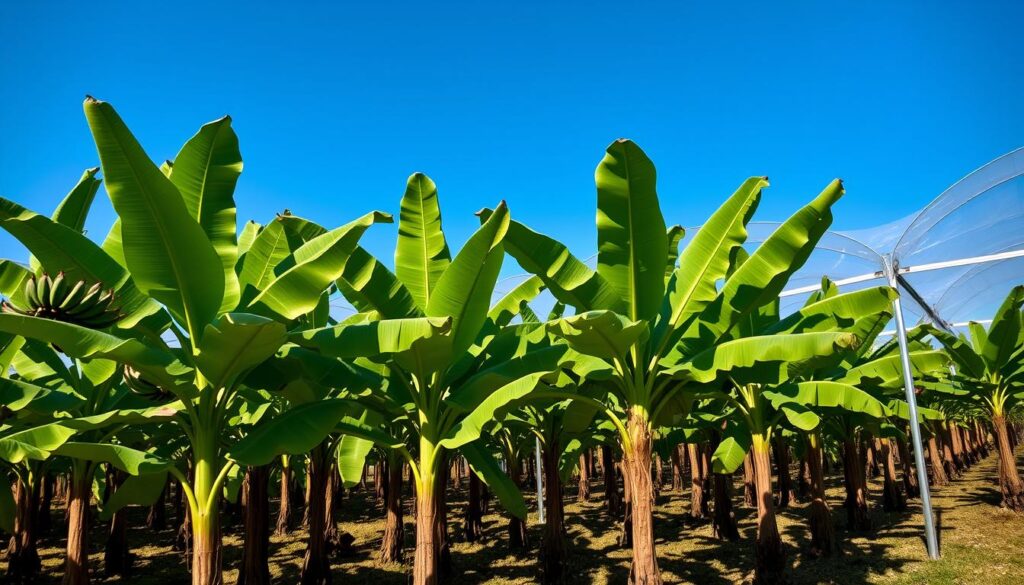
“Proper temperature control is crucial for the long-term health and productivity of banana plants. By understanding the ideal ranges and implementing protective measures, you can create the perfect growing environment for your banana care.”
Humidity Requirements and Management
Keeping the right humidity is key for your banana plants’ health. They love a humid environment, with levels between 60% to 90%. But, it can be hard to keep this humidity in indoor spaces, where heaters and air conditioners dry out the air.
Low humidity can make your banana plant’s leaves curl and turn brown. This not only looks bad but also slows down the plant’s growth. It also makes it easier for pests like spider mites to attack. On the flip side, too much humidity can lead to fungal diseases like leaf spot and root rot, harming your banana plant.
To give your banana plant the humidity it needs, try using a room humidifier. You can also place a tray with water and pebbles nearby or mist the leaves 2-3 times a week. Just make sure the leaves dry out by night to avoid fungal problems.
| Humidity Requirement | Ideal Range | Potential Issues |
|---|---|---|
| Banana Plants | 60-90% |
|
It’s important to check the humidity levels with a hygrometer and adjust as needed. This ensures your banana plant grows well and gives you plenty of fruit. By watching the humidity closely, you can help your banana plant thrive.
“Maintaining the right balance of humidity is vital to prevent diseases like Panama disease and black leaf streak disease in banana plants.”
Banana Care: Complete Maintenance Guide
To keep a banana plant healthy, you need a regular care plan. This is true whether it’s indoors or outdoors. Knowing what your plant needs every day, week, and month is key. A good maintenance plan helps your banana plant stay healthy and look great.
Daily Care Routine
Begin by checking if your banana plant gets enough light. It needs 6 to 8 hours of direct sunlight daily. Move the plant if it’s not getting enough light. Also, check the soil moisture and water when it’s dry to the touch.
Weekly Maintenance Tasks
- Look for pests or diseases on the leaves and stems. Clean the leaves with a damp cloth to remove dust and help with light absorption.
- Keep the air around the plant humid by misting the leaves or using a pebble tray with water.
- Remove any dead or damaged leaves to keep the plant looking neat and attractive.
Monthly Care Schedule
- Use a balanced, slow-release fertilizer from March to September. This gives the plant the nutrients it needs.
- Prune dead or dying leaves to help the plant focus on growing healthy.
- Check the plant’s health and adjust your care routine if needed.
By following this banana care routine, you’ll have a thriving banana plant. It will add a touch of the tropics to your space.
| Banana Care Maintenance | Tasks |
|---|---|
| Daily |
|
| Weekly |
|
| Monthly |
|
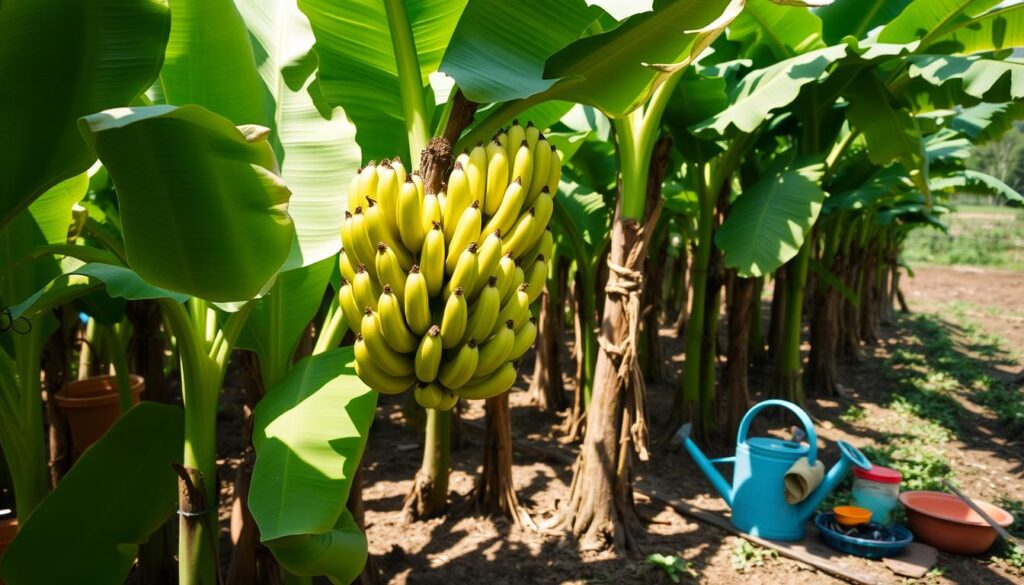
“Successful banana care is all about striking the right balance between providing the right amount of light, water, and nutrients for your plant to thrive.”
By following this banana care routine, you’ll have a thriving, lush banana plant. It will bring tropical vibes to your space.
Soil Selection and Preparation
To grow lush banana plants, start with the right soil. Banana plants thrive in well-draining, organic-rich soil with a pH between 5.5-7.5. You can use a potting mix for tropical plants or make your own mix with organic soil and perlite for better drainage.
Good drainage is key for banana care. Make sure your pot or planting area has enough holes for water to drain. This prevents waterlogging, which can cause root rot. When you repot, choose a wide, shallow container for the plant’s shallow roots.
| Soil Characteristic | Ideal Range |
|---|---|
| pH | 5.5 – 7.5 |
| Drainage | Well-draining |
| Organic Matter | Rich in organic content |
| Texture | Loamy |
With the right soil preparation, your banana plants will flourish. They’ll grow well and give you plenty of fruit. The right soil is the first step to a successful banana plant.
Fertilization Techniques and Timing
Banana plants need regular fertilizing to grow well. A good fertilization plan is key. Use a balanced, liquid fertilizer every 2-4 weeks during the growing season. Banana plants need nitrogen, phosphorus, and to grow well. Stop fertilizing in winter when growth slows.
Types of Fertilizers
There are many fertilizers for bananas. Use high-nitrogen fertilizer monthly during the growing season. Organic fertilizers or compost are good alternatives for natural nutrients.
Application Schedule
- For mature banana plants, use 1 ½ pounds (680 g.) of 8-10-10 fertilizer monthly.
- For dwarf indoor banana plants, use half that amount.
- Feed by digging fertilizer around the plant or mix it with water for each watering.
Signs of Nutrient Deficiency
Watch your banana plant for signs of nutrient deficiency. Yellow leaves and stunted growth are signs. Fix these issues quickly to keep your plant healthy.
| Nutrient | Deficiency Symptoms | Recommended Action |
|---|---|---|
| Nitrogen (N) | Yellowing of leaves | Apply 100g urea per plant |
| Phosphorus (P) | Marginal chlorosis | Apply 50g Diammonium phosphate |
| Potassium (K) | Poor fruit quality, smaller and badly shaped fruits | Adjust fertilizer ratio |
| Magnesium (Mg) | Leaf yellowing and purple mottling of petioles | Apply Epsom salts |
| Calcium (Ca) | Inferior fruit quality and splitting of the fruit when ripe | Apply calcium-based fertilizer |
| Sulfur (S) | Stunted growth and small bunches, leaves take on a silver-green color | Apply sulfur-containing fertilizer |
| Boron (B) | Reduced bunch weight and improper filling, leaf curling and deformation | Apply boron-containing fertilizer |
| Iron (Fe) | Interveinal chlorosis of young leaves | Apply iron-containing fertilizer |
| Zinc (Zn) | Narrow pointed and chloritic young leaves, bunch top crowns | Apply zinc-containing fertilizer |
Knowing what your banana plants need and watching for nutrient deficiencies helps them grow well. This way, you’ll get plenty of fruit.
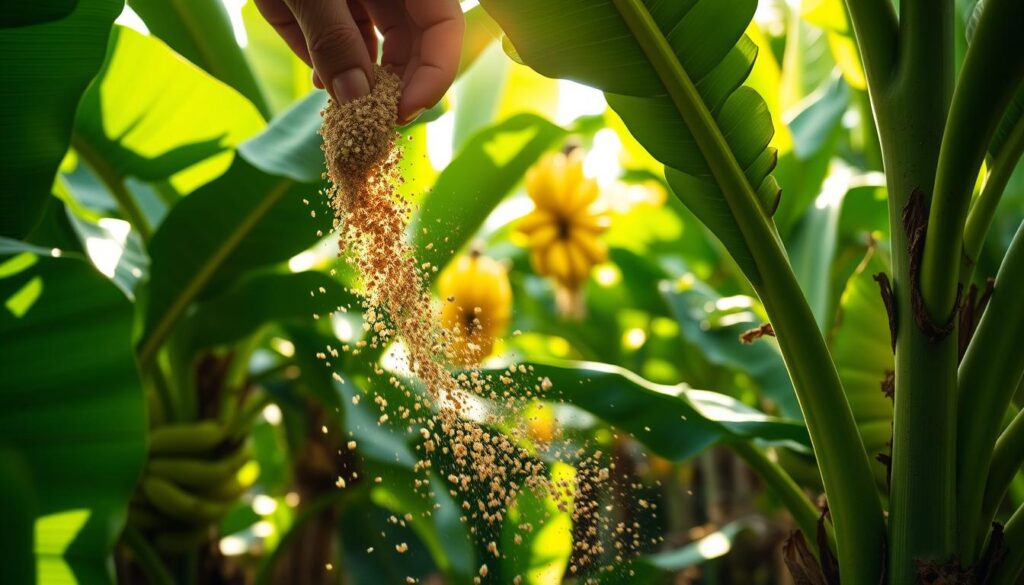
Repotting Guidelines and Root Care
Caring for your banana plant is more than just watering and sunlight. It’s also about repotting and keeping the roots healthy. Follow these expert tips to make sure your banana plant stays healthy for years.
Repotting Frequency and Pot Size
Repot your banana plant every 2-3 years or when the roots fill the pot. Choose a new pot that’s 20% bigger than the old one. This gives the roots room to grow without getting too wet.
Repotting Process
- Repot in the spring to avoid stressing the plant.
- Use a potting mix made for tropical plants.
- Loosen the roots gently and check for damaged or rotting roots. Cut these with sterilized pruners.
- Put the plant in the new pot, making sure the root crown is 1 inch below the rim. This prevents water from spilling over.
- Water well after repotting and keep it in a shaded area for a few days to help it recover.
Proper root care is key for your banana plant’s health. Regular checks and quick action to any problems will help your plant thrive.
For more banana care tips, check out our detailed guides on keeping your plant in the best conditions.
“Repotting is essential for the long-term health and growth of your banana plant. It allows the roots to spread and access the nutrients they need to produce lush foliage and bountiful fruit.”
Propagation Methods and Tips
Growing your own banana plants is rewarding. It starts with successful propagation. You can use offset division or seed propagation. Let’s look at these methods and essential tips for growing banana plants.
Offset Division Technique
Offset division is a common way to grow banana plants. It involves separating baby plants, or “pups,” from the mother plant. Look for strong suckers that are at least three feet tall and part of a big clump.
Dig around the base carefully, avoiding root damage. Gently remove the pup with its roots. Plant it in well-draining soil and keep it warm and lightly shaded. You’ll see growth in 2-3 weeks.
Seed Propagation Process
Seed propagation is another way to grow banana plants. Soak the seeds in water for 24 hours to help them germinate. Plant the soaked seeds in seedling trays with a good potting mix.
Keep the area humid and warm, around 75-85°F (24-29°C). This process takes weeks. Once the seedlings have their first leaves, move them to bigger containers or the ground.
Successful banana propagation needs care and attention. Whether using offset division or seed propagation, ensure the right conditions. This includes warmth, moisture, and indirect light. With patience and the right techniques, you’ll enjoy a bountiful banana harvest soon.
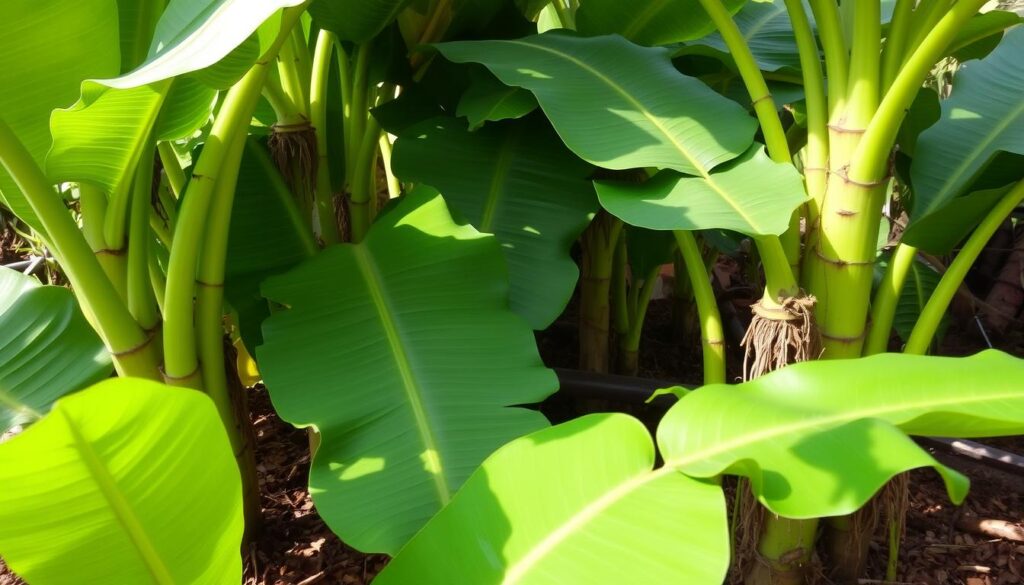
“Propagating banana plants is an incredibly rewarding process, allowing you to multiply your plants and share the joy of growing these tropical wonders.”
Common Growing Problems and Solutions
Banana plants are tough but can face many challenges. Knowing how to solve these problems is key to keeping your banana plant healthy. Let’s look at some common issues and how to fix them.
Leaf yellowing is a big problem, often due to too much water or not enough nutrients. Not enough potassium can turn the edges of leaves yellow. A lack of magnesium can make the middle of leaves yellow. Nitrogen or sulfur shortages can also make leaves turn yellow.
Fusarium wilt is another big problem. It’s a fungal disease that can turn leaves yellow and kill the plant. This disease wiped out the Gros Michel banana variety.
Cracking of banana fruit happens when it’s too hot and there’s too much moisture. Keeping the plant’s moisture level steady is important to avoid this.
| Problem | Cause | Solution |
|---|---|---|
| Leaf Yellowing | Overwatering, Nutrient Deficiency | Adjust watering schedule, Apply balanced fertilizer |
| Fusarium Wilt | Fungal Disease | Implement preventative measures, Use resistant varieties |
| Fruit Cracking | High Temperatures, Excessive Moisture | Maintain consistent moisture levels, Provide shade during hot periods |
Root rot is a big problem caused by too much water. It’s important to water your banana plant right and make sure the soil drains well.
Temperature changes can hurt banana plants too. They grow best in temperatures between 75-85°F. Keeping the temperature stable is important.
Pests like aphids and spider mites can be a problem. Using natural solutions like neem oil or insecticidal soap can help control them.
By quickly fixing these common problems and using the right solutions, you can keep your banana plants healthy. Regular checks and care are essential for a thriving banana garden.
Indoor vs Outdoor Growing Considerations
Keeping banana plants healthy needs regular care, indoors or outdoors. When moving your banana plant outside for summer, slowly get it used to the change. Pick a spot that’s safe from strong winds to protect the leaves.
Transitioning Between Indoor and Outdoor Environments
When moving your banana plant outside, start by letting it get used to more light and air. Do this over a week or two. This helps the plant adjust and prevents stress. When bringing it back inside before it gets too cold, do the same gradual introduction.
Seasonal Care Differences
Outdoor banana plants need more water and food because they get more sunlight and grow faster. Increase how often you water and feed it during the growing season. In the cold months, when the plant is dormant, water and feed it less to avoid too much water and nutrients.
